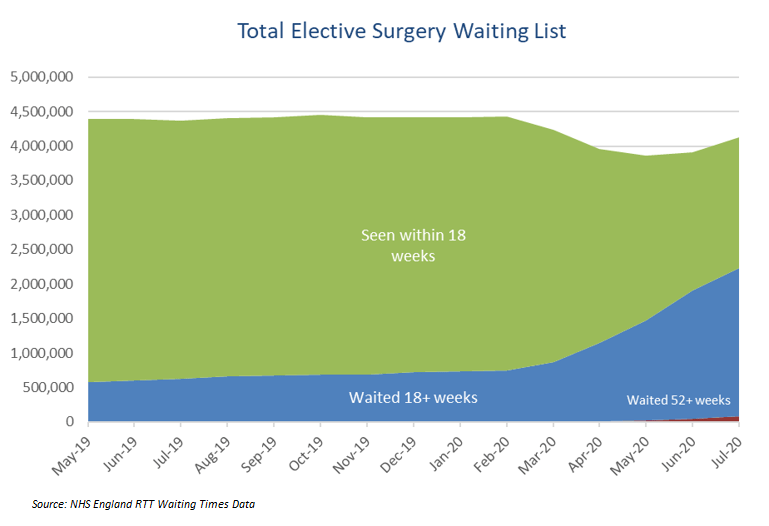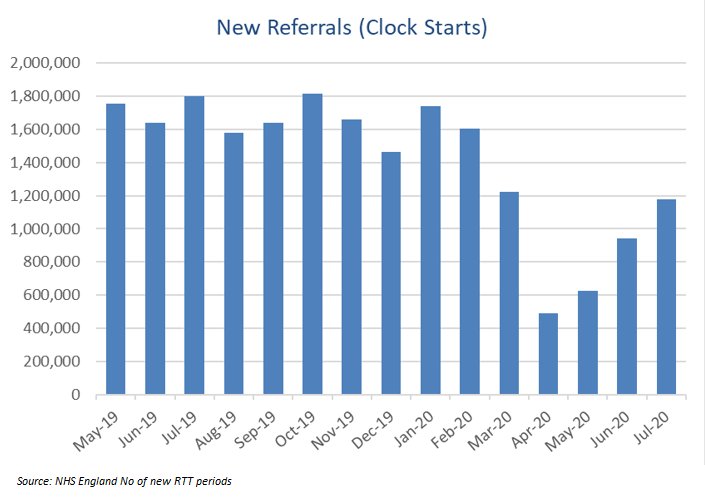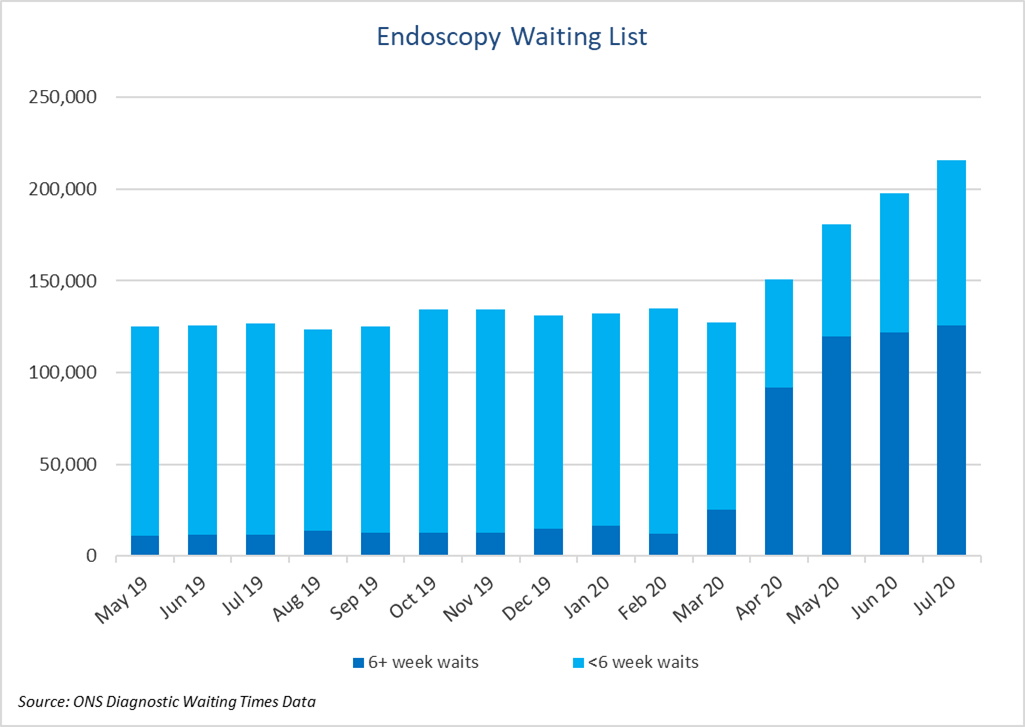Það lítur út fyrir að þú sért í Bandaríkjunum
Við erum með aðra síðu (www.q-bital.com) sem hentar betur staðsetningu þinni
Þar sem biðtími heldur áfram að lengjast eftir valkvæðum skurðaðgerðum og greiningaraðgerðum, hvað er hægt að gera til að taka á eftirstöðvunum?
Nýjustu tölur frá NHS Englandi, sem ná yfir tímabilið fram að júlí 2020, sýna að biðtímar hafa haldið áfram að hækka hratt, þrátt fyrir að fjöldi nýrra tilvísana sé enn lítill og virkni aukist.
Eins og myndin sýnir fækkaði heildarfjöldi fólks á biðlista tímabundið í mars og apríl, aðallega vegna samdráttar í tilvísunum, en fer nú hægt en stöðugt vaxandi. Mikilvægara er þó að sá tími sem sjúklingar bíða eftir meðferð hefur aukist verulega.
 Í júlí var fjöldi fólks sem hafði verið á biðlistum í meira en 18 vikur sá mesti síðan mælingar hófust, eða 2,15 milljónir. Þetta þýðir að yfir helmingur þeirra sem bíða eftir meðferð - 53% - hefur beðið í meira en 18 vikur eftir meðferð. Fyrir heimsfaraldurinn var þetta hlutfall í kringum 13-14% af heildinni í „venjulegum“ mánuði.
Í júlí var fjöldi fólks sem hafði verið á biðlistum í meira en 18 vikur sá mesti síðan mælingar hófust, eða 2,15 milljónir. Þetta þýðir að yfir helmingur þeirra sem bíða eftir meðferð - 53% - hefur beðið í meira en 18 vikur eftir meðferð. Fyrir heimsfaraldurinn var þetta hlutfall í kringum 13-14% af heildinni í „venjulegum“ mánuði.
Þar að auki höfðu meira en 83.000 sjúklingar beðið í meira en ár eftir meðferð í júlí 2020. Þetta var veruleg aukning miðað við fyrir ári síðan og var mesti fjöldi 52 vikna þjóna sem sést hafa síðan 2008.
Þótt eitthvað jákvætt sé í gögnunum, nefnilega að virkni almennt og fjöldi nýrra tilvísana hafi aukist, þá er enn langt í land. Í júlí, þrátt fyrir verulega aukningu, voru valinntökur innan við helmingur þess fjölda sem sást fyrir ári síðan.
Fjöldi nýrra tilvísana hefur aukist mikið frá því í maí, en haldist vel undir eðlilegum mörkum og virðist sem væntanleg frestun tilvísana frá tímabilinu mars til júní sé enn ekki komin í gegn.
 Í nýlegri
grein í BMJ
Haft var eftir Neil Mortensen, forseta Royal College of Surgeons of England, að hann væri vonsvikinn yfir því að sjá biðlistum fjölgaði í júlí, tveimur mánuðum eftir að NHS birti vegakort til að endurheimta venjubundna umönnun.
Í nýlegri
grein í BMJ
Haft var eftir Neil Mortensen, forseta Royal College of Surgeons of England, að hann væri vonsvikinn yfir því að sjá biðlistum fjölgaði í júlí, tveimur mánuðum eftir að NHS birti vegakort til að endurheimta venjubundna umönnun.
Hann sagði; „Við þurfum brýn að byggja upp spítalaforða okkar ef við ætlum að ná þessum vetri í gegn. Flensa, ásamt áframhaldandi staðbundnum Covid-19 faraldri, má ekki koma í veg fyrir að aðgerð stöðvast aftur, eða þúsundir til viðbótar munu þjást. Þetta sýnir alvarleika málsins og skort á seiglu innan víðfeðma hluta heilbrigðisþjónustu Bretlands.
Nýjustu speglunargögnin sögðu svipaða sögu. Verið var að gera fleiri speglanir og magaspeglun, þar sem virkni meira en tvöfaldaðist í júní og jókst um 45% til viðbótar í júlí, en þrátt fyrir það er virknin enn langt undir eðlilegum mörkum.
Heildarfjöldi þeirra sem biðu eftir speglunarskoðun í júlí 2020 var um 216.000 – jókst um 70% samanborið við júlí í fyrra, en vöxtur sýndi engin merki um að hægja á sér.
 Þó að fjöldi fólks sem bíður í meira en 18 vikur hafi náð jafnvægi á milli maí og júlí, er hlutfallið óeðlilegt og meðal þessara sjúklinga munu vera margir sem halda áfram að lengjast lengur en í 18 vikur. Í júlí biðu um 126.000 manns - meira en helmingur þeirra sem biðu eftir speglunarskoðun - í meira en 18 vikur, samanborið við um 12.000 fyrir ári síðan.
Þó að fjöldi fólks sem bíður í meira en 18 vikur hafi náð jafnvægi á milli maí og júlí, er hlutfallið óeðlilegt og meðal þessara sjúklinga munu vera margir sem halda áfram að lengjast lengur en í 18 vikur. Í júlí biðu um 126.000 manns - meira en helmingur þeirra sem biðu eftir speglunarskoðun - í meira en 18 vikur, samanborið við um 12.000 fyrir ári síðan.
Þessar tölur eru skelfilegar en ekki óvæntar og þótt líklegt sé að umsvif hafi aukist enn frekar í ágúst og september á eftir að koma í ljós hvort þetta hafi skipt sköpum fyrir biðtíma.
Jafnframt benda tölurnar til þess að við gætum verið á leið í krefjandi haust- og vetrarvertíð og að það verði ótrúlega erfitt að ná þessu. Hægur bati á valbiðlistanum gefur vísbendingu um hversu langan tíma það gæti tekið að komast að fullu umfangi frestaðrar eftirspurnar frá lokunartímabilinu.
Með einum eða öðrum hætti þarf að auka getu verulega ef NHS á að eiga möguleika á að stytta biðtíma eftir valmeðferðum og aðgerðum. Sveigjanleg innviði heilbrigðisþjónustu, svo sem farsíma og mát skurðstofum og meðferðarherbergi, geta veitt skjóta og árangursríka lausn á stigvaxandi biðlistum.
Það sem er líka ljóst er að þetta ástand mun vera viðvarandi í langan tíma og þarf meira en skammtíma lagfæringar. Einingabygging, sem hýsir skurðstofu, meðferðarherbergi eða deild, er hægt að byggja nálægt varanlegum staðli á mjög stuttum tíma, og einnig er hægt að stilla og fullbúa það að þörfum hvers viðskiptavinar. Slík bygging veitir viðbótar Covid-light rými og aukna tryggingu fyrir sjúklinga með því að bjóða upp á algjörlega aðskilinn inngang og móttökusvæði, auk sérstakt ferðalag sjúklinga til þess sem er á aðalsjúkrahúsinu.



Vanguard Healthcare Solutions
Eining 1144 Regent Court, The Square, Gloucester Business Park, Gloucester, GL3 4AD

Við erum með aðra síðu (www.q-bital.com) sem hentar betur staðsetningu þinni